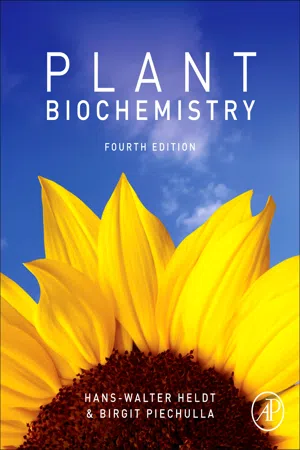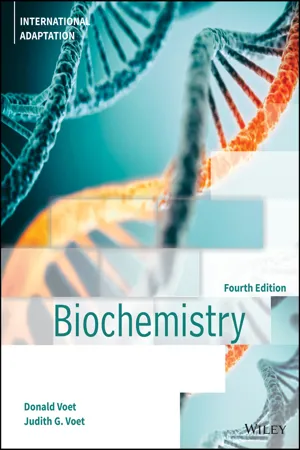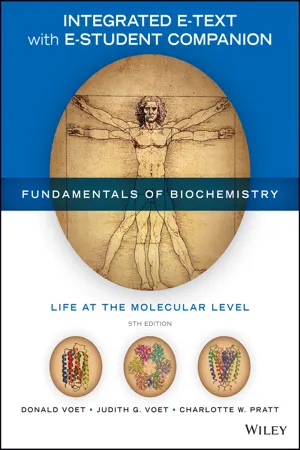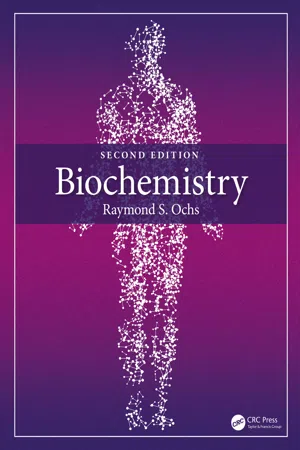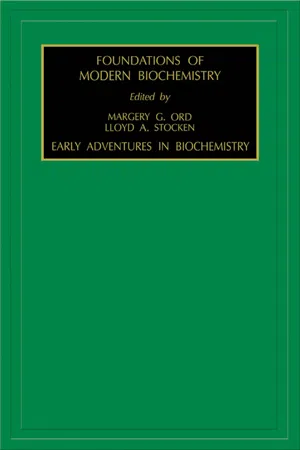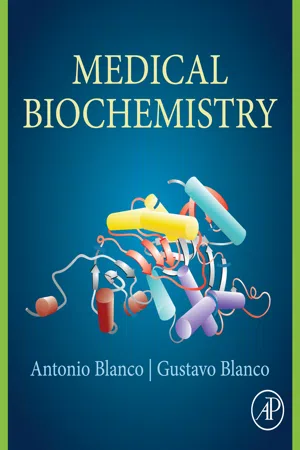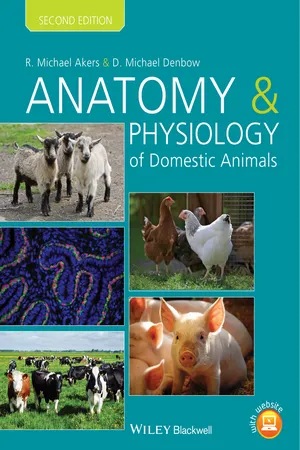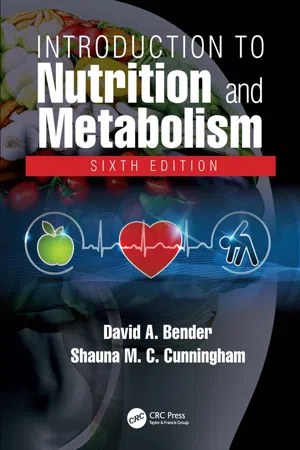Biological Sciences
Oxidative phosphorylation
Oxidative phosphorylation is the process in which energy is produced in cells through the transfer of electrons from electron donors to electron acceptors. This process occurs in the inner mitochondrial membrane and involves the generation of ATP, the cell's primary energy currency. It is a key component of cellular respiration and plays a crucial role in the production of energy for various cellular activities.
Written by Perlego with AI-assistance
Related key terms
Related key terms
1 of 4
Related key terms
1 of 3
10 Key excerpts on "Oxidative phosphorylation"
- eBook - ePub
- Hans-Walter Heldt, Birgit Piechulla(Authors)
- 2010(Publication Date)
- Academic Press(Publisher)
5 Mitochondria are the power station of the cellIn the process of biological oxidation, substrates such as carbohydrates are oxidized to form water and CO2 . Biological oxidation can be seen as a reversal of the photosynthesis process. It evolved only after oxygen accumulated in the atmosphere during photosynthesis. Both biological oxidation and photosynthesis serve the purpose of generating energy in the form of ATP. Biological oxidation involves a transport of electrons through a mitochondrial electron transport chain, which is in part similar to the photosynthetic electron transport discussed in Chapter 3 . The present chapter will show that the machinery of mitochondrial electron transport is also assembled of three modules. The second complex has the same basic structure as the cytochrome-b 6 /f complex of the chloroplasts. As in photosynthesis, the mitochondrial oxidative electron transport and ATP synthesis are coupled to each other via a proton gradient. The synthesis of ATP proceeds by an F-ATP synthase, which was described in Chapter 4 .5.1 Biological oxidation is preceded by a degradation of substrates to form bound hydrogen and CO2The overall reaction of biological oxidation is equivalent to a combustion of substrates. In contrast to technical combustion, however, biological oxidation proceeds in a sequence of partial reactions, which allows the utilization of the major part of the free energy for ATP synthesis.The principle of biological oxidation was formulated in 1932 by the Nobel Prize winner Heinrich Wieland (Germany):First, hydrogen is removed from substrate XH2 and afterwards oxidized to water. The oxidation of carbohydrates [CH2 O]ninvolves a degradation by reaction with water to form CO2 and bound hydrogen [H], which is oxidized to water:In 1934 Otto Warburg (Berlin, winner of the 1931 Nobel Prize in Medicine) showed that the transfer of bound hydrogen from substrates to the site of oxidation occurs in the form of NADH . From studies with homogenates from pigeon muscles, Hans Krebs formulated the citrate cycle (also called the Krebs cycle) in England in 1937, as a mechanism for substrate degradation yielding NADH for biological oxidation. In 1953 he was awarded the Nobel Prize in Medicine for this discovery. The operation of the citrate cycle will be discussed in detail in section 5.3 - eBook - ePub
- Pascal Leclair(Author)
- 2023(Publication Date)
- CRC Press(Publisher)
9 The Energy of Cells Part II Oxidative phosphorylationDOI: 10.1201/9781003379058-9We saw in Chapter 5 that foodstuff initially gets broken down in the glycolytic pathway, quickly yielding a small burst of energy usable by cells. During anaerobic respiration, which includes the process of fermentation, this pathway results in the accumulation of lactic acid in mammals or ethanol and CO2 in yeast and other fermenting organisms. However, if oxygen is available, the end-product of glycolysis, the three-carbon molecule, pyruvic acid, is converted to a high-energy compound, acetyl-CoA, which then combines with oxaloacetate to form citric acid, the first molecule of the Krebs cycle. The Krebs cycle is a series of redox reactions that create FADH2 and NADH as by-products and its end-product, oxaloacetate, is recycled to form citrate in a new cycle. The end result of glycolysis and the Krebs cycle is the net synthesis of ATP, whose terminal phosphates can be used as a signaling tag (discussed in Chapters 12 and 13 ) or as a high-energy bond to enable cellular reactions. In this chapter, we discuss the experiments which allowed the elucidation of the mechanism of Oxidative phosphorylation, that is, how FADH2 and NADH donate electrons to the electron transfer chain of mitochondria—the powerhouse of the cell and the main site of ATP synthesis—which creates a H+ gradient across the mitochondrial membrane that fuels the synthesis of ATP.In 1932, Otto Warburg and W. Christian identified a new class of molecules involved in the transfer of hydrogen ions. Warburg had always been suspicious about the reactions occurring in Thunberg tubes and questioned whether they were physiologically relevant.1 However, a visit to a colleague’s laboratory in the U.S. was to change his mind. A colleague performed some experiments on red blood cells for him which showed that methylene blue was reduced in the metabolism of glucose to CO2 and pyruvate. Warburg was intrigued by this phenomenon and, therefore, began an investigation of the chemistry of methylene blue.1 As such, he found that incubation of ATP, glucose-6-phosphate (the first intermediate of glycolysis), and methylene blue with yeast cell extracts led to an O2 uptake, and dialysis of the extracts revealed that two components were required for this hydrogen-transferring process: a heat-labile enzyme and a heat-stable co-enzyme.1 The enzyme component was further fractionated into two components, one of which had a yellow color when oxidized and became clear when reduced—this molecule was appropriately named “yellow enzyme”.2 This substance, which Warburg and Christian succeeded in isolating a few years later, was later called lumiflavin and was determined to be part of a greater family of molecules called flavoproteins which are used as carriers of hydrogen (Figure 9.1 - eBook - ePub
- David Stern(Author)
- 2009(Publication Date)
- Academic Press(Publisher)
Chapter 13. Oxidative phosphorylation - Building Blocks and Related Components
I. Introduction
Oxidative phosphorylation (OXPHOS) is defined as an electron transfer chain driven by substrate oxidation that is coupled to the synthesis of ATP through an electrochemical transmembrane gradient (Figure 13.1 ). Historically, bovine heart mitochondria have been the system of choice for the structural characterization of eukaryotic OXPHOS complexes (Saraste, 1999 ), because they can be purified in relatively large quantities. The yeast Saccharomyces cerevisiae, which is amenable to a large variety of molecular genetic tools (Bonnefoy and Fox, 2002 ), has become the model organism to study the biogenesis of mitochondrial complexes (Barrientos et al., 2002 ; Herrmann and Neupert, 2003 ) and the effect of mutations on OXPHOS components (Fisher et al., 2004 ). By contrast, mitochondria of photosynthetic organisms have been poorly characterized from a biochemical point of view, mainly due to the difficulties in obtaining preparations free of chloroplast contaminants. Nevertheless, the characterization of Arabidopsis mitochondrial components through proteomic approaches has advanced significantly (Millar et al., 2005 ).Figure 13.1. The oxidative phosporylation (OXPHOS) system in the inner membrane of plant mitochondria. Electrons are transferred from NADH and NAD(P)H to coenzyme Q (Q) via type-I NADH:ubiquinone oxidoreductase or complex I (I) and type-II alternative NADH dehydrogenases (NDA; located on the internal (int) or external (ext) faces of the inner membrane). Some electrons from organic acid oxidation are also transferred to Q via the succinate dehydrogenase or complex II (II). Electrons are thereafter transferred from reduced coenzyme Q (QH2) to cytochrome c (cyt c) via the ubiquinol:cytochrome c oxidoreductase or complex III (III) and then to oxygen via the cytochrome c oxidase or complex IV (IV). An alternative oxidase (AOX) can bypass complexes III and IV by transferring electrons directly from QH2 to oxygen. The oxidoreduction reactions mediated by complexes I, III, and IV are coupled with protons (H1) transfer from the matrix to the intermembrane space. The energy associated with the proton gradient is used for the production of ATP by complex V (ATP synthase) or dissipated by uncoupling proteins (UCP).
- eBook - ePub
- Donald Voet, Judith G. Voet(Authors)
- 2021(Publication Date)
- Wiley(Publisher)
20 Electron Transport and Oxidative phosphorylationIn 1789, Armand Séguin and Antoine Lavoisier (the father of modern chemistry) wrote:1 The MitochondrionA. Mitochondrial AnatomyB. Mitochondrial Transport Systems2 Electron TransportA. Thermodynamics of Electron TransportB. The Sequence of Electron TransportC. Components of the Electron-Transport Chain3 Oxidative phosphorylationA. Energy Coupling HypothesesB. Proton Gradient GenerationC. Mechanism of ATP SynthesisD. Uncoupling of Oxidative phosphorylation4 Control of ATP ProductionA. Control of Oxidative phosphorylationB. Coordinated Control of ATP ProductionC. Physiological Implications of Aerobic versus Anaerobic Metabolism. . . in general, respiration is nothing but a slow combustion of carbon and hydrogen, which is entirely similar to that which occurs in a lamp or lighted candle, and that, from this point of view, animals that respire are true combustible bodies that burn and consume themselves.Lavoisier had by this time demonstrated that living animals consume oxygen and generate carbon dioxide. It was not until the early twentieth century, however, after the rise of enzymology, that it was established, largely through the work of Otto Warburg, that biological oxidations are catalyzed by intracellular enzymes. As we have seen, glucose is completely oxidized to CO2 through the enzymatic reactions of glycolysis and the citric acid cycle. In this chapter we shall examine the fate of the electrons that are removed from glucose by this oxidation process.The complete oxidation of glucose by molecular oxygen is described by the following redox equation: To see more clearly the transfer of electrons, let us break this equation down into two half-reactions. In the first half-reaction the glucose carbon atoms are oxidized: - eBook - ePub
Fundamentals of Biochemistry, Integrated E-Text with E-Student Companion
Life at the Molecular Level
- Donald Voet, Judith G. Voet, Charlotte W. Pratt(Authors)
- 2017(Publication Date)
- Wiley(Publisher)
0 components of ATP synthase. Which parts move? Which are stationary? Which are mostly stationary but undergo conformational changes?- Summarize the steps of the binding change mechanism.
- Describe how protons move from the intermembrane space into the matrix. How is proton translocation linked to ATP synthesis?
- Explain why the P/O ratio for a given substrate is not necessarily an integer.
- Explain how Oxidative phosphorylation is linked to electron transport and how the two processes can be uncoupled.
- Summarize the energy transformations that occur in converting the free energy of glucose to the free energy of ATP.
4 Control of Oxidative Metabolism
KEY CONCEPTS
- The rate of Oxidative phosphorylation is coordinated with the cell’s other oxidative pathways.
- Although aerobic metabolism is efficient, it leads to the production of reactive oxygen species.
An adult woman requires some 1500 to 1800 kcal (6300–7500 kJ) of metabolic energy per day. This corresponds to the free energy of hydrolysis of over 200 mol of ATP to ADP andP i. Yet the total amount of ATP present in the body at any one time is <0.1 mol; obviously, this sparse supply of ATP must be continually recycled. As we have seen, when carbohydrates serve as the energy supply and aerobic conditions prevail, this recycling involves glycogenolysis, glycolysis, the citric acid cycle, and Oxidative phosphorylation.Box 18-4 Perspectives in Biochemistry
Uncoupling in Brown Adipose Tissue Generates Heat
Heat generation is the physiological function of brown adipose tissue (brown fat). This tissue is unlike typical (white) adipose tissue in that it contains numerous mitochondria whose cytochromes cause its brown color. Newborn mammals that lack fur, such as humans, as well as hibernating mammals, all contain brown fat in their neck and upper back that generates heat by nonshivering thermogenesis. Other sources of heat are the ATP hydrolysis that occurs during muscle contraction (in shivering or any other movement) and the operation of ATP-hydrolyzing substrate cycles (see Section 15-4B - eBook - ePub
- Raymond S. Ochs(Author)
- 2021(Publication Date)
- CRC Press(Publisher)
For example, rather than just two reactions, the malate/aspartate shuttle requires six. The cycle is neatly balanced as glutamate and α-ketoglutarate needed at the transamination steps are transported in the correct directions in the operation of the pathway. Despite the apparent complexity, this is by far the more common route for the delivery of reducing equivalents into the mitochondria. We will see some of the same reactions of the malate/aspartate shuttle utilized in other pathways (and shuttles applied more generally), in the gluconeogenic and lipid pathways, and in nitrogen metabolism. However, before we study additional pathway connections, we will first discuss photosynthesis – a pathway that, like Oxidative phosphorylation, extracts energy and can be understood based on the chemiosmotic hypothesis. Summary Oxidative phosphorylation is the major pathway for the extraction of energy from food. There are two linked, vectorial flows: electrons from NADH to O 2, and protons from the mitochondrial matrix to the cytosol. These flows establish a proton gradient that leaves the mitochondrial matrix with a lower concentration of protons and a negative electrical charge. The return of protons to the matrix is coupled to ATP synthesis. Five protein complexes are responsible for these activities, known as complexes I through V (as well as having more descriptive names). The first four are electron carriers, and the fifth catalyzes ATP synthesis. Each of the complexes is embedded in the mitochondrial inner membrane and is physically isolated from the other four. Communication occurs exclusively through mobile cofactors. NADH, UQ, and cytochrome c connect complexes I through IV - eBook - ePub
- L.A. Stocken, M.G. Ord(Authors)
- 1995(Publication Date)
- Elsevier Science(Publisher)
A different and simpler approach to the measurement of P/O ratios came from the introduction of an oxygen electrode suitable for biochemical studies. Chance and Williams (1955) established conditions under which mitochondrial respiration, in the presence of excess substrate, was totally dependent on the amount of ADP available, i.e., the mitochondria were exhibiting respiratory control. From the change in potential when a known amount of ADP was admitted into the electrode vessel, the oxygen uptake and thus the P/O ratio could be determined, completely confirming the earlier results.By the mid-1950s, therefore, it had become clear that oxidation in the tricarboxylic acid cycle yielded ATP. The steps had also been identified in the electron transport chain where this apparently took place. Most biochemists expected Oxidative phosphorylation would occur analogously to substrate level phosphorylation, a view that was tenaciously and acrimoniously defended. Most hypotheses entailed the formation of some high-energy intermediate X ∼Y which, in the presence of ADP and Pi would release X and Y and yield ATP. A formulation of the chemical coupling hypothesis was introduced by Slater in 1953,AH2 + B + C A ∼ C + BH2 (i)A∼C + ADP + Pi A + C + ATP (ii)and was representative of ideas then under consideration. There was considerable discussion regarding the oxidation state of the postulated high-energy intermediate, which was alternatively regarded as being in the reduced state: BH2 ∼C. Claims were in fact made between the late 1950s and early 1960s for the existence of such derivatives (e.g. NADH ∼P) but no confirmation was forthcoming. One of the most persistent, though not logically rigorous, arguments against the high-energy intermediate theory was the continuing inability to detect such intermediates.Sophisticated isotope experiments were also performed using H2 18 O (Mildred Cohn) and P, and various exchange reactions identified between ATP, ADP, and Pi - eBook - ePub
- Antonio Blanco, Gustavo Blanco(Authors)
- 2017(Publication Date)
- Academic Press(Publisher)
i ). The energy is transferred to form a high energy phosphate bond in guanosine triphosphate (GTP) is synthesized. The reaction is catalyzed by succinate thiokinase.GTP, in turn, can transfer phosphate to ADP to yield ATP: GTP + ADP ⇋ GDP + ATP Phosphorylation at a substrate level, in contrast to Oxidative phosphorylation, does not require the presence of oxygen to form ATP.Other electron transport systems
There are electron transport systems different from the respiratory chain, not involved in ATP synthesis, but in substrate hydroxylation or dehydrogenation reactions.For hydroxylations, the systems require NADPH and O2 . One oxygen atom of the molecule is incorporated into the substrate and the other is reduced to H2 O. The process can be represented by the following equation (A = substrate):AH + O2 + NADPH + H+ → AOH + H2 O + NADP+The enzymes that catalyze these reactions are designated monooxygenases or mixed function oxygenases .Introduction of a −OH group is a resource commonly used by liver cells as a mechanism of biotransformation of foreign substances. Hepatocytes have an electron transport system responsible for hydroxylations. It is attached to the endoplasmic reticulum and can be isolated with the microsomal fraction. The system contains a FAD flavoprotein called NADPH–cytochrome P 450 reductase and cytochrome P 450 . Cytochrome P450 is a heme protein of approximately 50 kDa, anchored to membranes, belongs to the cytochrome-b group, and has an absorption maximum at 450 nm when bound to CO. In humans there is a large family of genes encoding P450 enzymes of different specificity.NADPH donates reducing equivalents to NADPH–cytochrome P450 reductase and this transfers electrons to cytochrome P450 . In the final step, cytochrome P450 - eBook - ePub
- R. Michael Akers, D. Michael Denbow(Authors)
- 2013(Publication Date)
- Wiley-Blackwell(Publisher)
As we have seen, each turn of the Krebs cycle only generates two molecules of ATP via substrate-level phosphorylation. The key depends on a cluster of interrelated membrane-bound enzymes that make up the electron transport chain. The activity of these enzymes also accounts for essentially all of our need for oxygen. As the electron chain enzymes function, the hydrogen atoms (electrons) that are removed as various intermediates of glycolysis and Krebs cycle are oxidized and are progressively passed along until they are combined with oxygen. Oxygen is the final electron acceptor in the chain so that water is formed. The reduced forms of both NADH and FADH 2 that were generated in the Krebs cycle become oxidized again as their hydrogen is donated to the electron chain enzymes. Energy that is produced as electrons passes ultimately to oxygen and is indirectly used to power the attachment of inorganic phosphate groups to ADP to create ATP. The enzyme responsible for this final step is ATP synthase, whose activity is linked to the movement of hydrogen atoms down a concentration gradient across the membrane of the mitochondria. Some of the energy from the action of the electron transport chain acts to transport hydrogen ions out of the mitochondrial matrix space. The resulting electrochemical gradient drives hydrogen ions back across the membrane in conjunction with ATP synthase leading to ATP generation. Because of the need for oxygen as the final electron acceptor in the electron transport chain, the production of ATP in this manner is called Oxidative phosphorylation. Interestingly, the position along the electron transport chain at which FADH 2 or NADH + H + donate their electrons differs. Because of this, the amount of energy that is produced is greater for NADH compared with FADH 2. Specifically, each pair of hydrogen atoms from NADH + H + supplies energy for the creation of three ATP, but the two hydrogen atoms from FADH 2 yield only two ATP - eBook - ePub
- David A Bender, Shauna M C Cunningham(Authors)
- 2021(Publication Date)
- CRC Press(Publisher)
chapter threeThe Role of ATP in Metabolism
Adenosine triphosphate (ATP) acts as the central link between energy-yielding metabolic pathways and energy expenditure in physical and chemical work. The oxidation of metabolic fuels is linked to the phosphorylation of adenosine diphosphate (ADP) to ATP, while the expenditure of metabolic energy for the synthesis of body constituents, transport of compounds across cell membranes and the contraction of muscle results in the hydrolysis of ATP to yield ADP and phosphate ions. The total body content of ATP + ADP is under 350 mmol (about 10 g), but the amount of ATP synthesized and used each day is about 100 mol (about 70 kg), an amount equal to body weight.Objectives
After reading this chapter, you should be able to:• explain how endothermic reactions can be linked to the overall hydrolysis of ATP → ADP and phosphate• describe how compounds can be transported across cell membranes against a concentration gradient and explain the roles of ATP and proton gradients in active transport• describe the role of ATP in muscle contraction and the role of creatine phosphate as a phosphagen• describe the structure and functions of the mitochondrion and explain the processes involved in the mitochondrial electron transport chain and Oxidative phosphorylation, explain how substrate oxidation is regulated by the availability of ADP, and how respiratory poisons and uncouplers act.3.1 Adenine NucleotidesNucleotides consist of a purine or pyrimidine base linked to the 5-carbon sugar ribose. The base plus sugar is a nucleoside; in a nucleotide the sugar is phosphorylated. Nucleotides may be mono-, di- or triphosphates.Figure 3.1 The adenine nucleotides (the box shows the structures of adenine, guanine and uracil; guanine and uracil form a similar series of nucleotides).Figure 3.1 shows the nucleotides formed from the purine adenine – the adenine nucleotides, adenosine monophosphate (AMP), ADP and ATP. Similar families of nucleotides that are important in metabolism are formed from the guanine and uracil bases (see also Section 10.3.2 for a discussion of the role of cyclic AMP in metabolic regulation and hormone action, and Section 10.3.1
Index pages curate the most relevant extracts from our library of academic textbooks. They’ve been created using an in-house natural language model (NLM), each adding context and meaning to key research topics.
Explore more topic indexes
Explore more topic indexes
1 of 6
Explore more topic indexes
1 of 4
